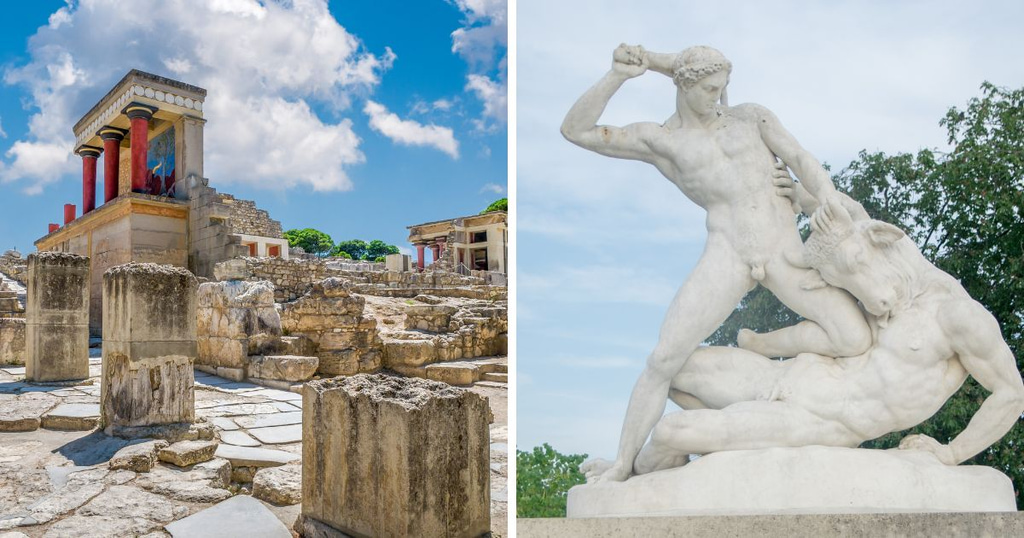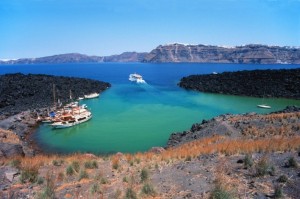The Mythology of Crete: Exploring Ancient Legends
Crete—the land where myth and history intertwine, where the echoes of gods and heroes still resonate through its rugged mountains and sun-drenched ruins. From the mighty Zeus to the labyrinthine prison of the Minotaur, the myths of Crete are as captivating as the island itself. Let’s step into this world of ancient wonders and uncover the legendary past of Greece’s largest island.
Zeus: The Divine Child of Mount Ida
Crete’s mythology begins with the birth of the king of the gods himself—Zeus. According to legend, his mother Rhea fled to the island to escape her vengeful husband, Cronus, who devoured his children to prevent them from overthrowing him. Hidden deep within the Ideon Cave, high up on Mount Ida, Zeus was secretly raised by the sacred goat Amaltheia while the Kouretes, warrior-priests, clashed their weapons together to drown out his cries.
Today, visitors can venture into the Ideon Cave, feeling the whispers of myth that linger in the cool, shadowed depths. It’s a place where history meets legend, a gateway to the very origins of Greek mythology.
Knossos and the Minotaur’s Labyrinth
Perhaps Crete’s most famous tale is that of King Minos and the monstrous Minotaur. The myth tells of how Minos, ruler of Crete, angered the god Poseidon, who cursed his wife Pasiphaë to fall in love with a sacred bull. From this unnatural union, the Minotaur was born—a fearsome creature, half-man and half-bull. To imprison the beast, Minos commanded the legendary craftsman Daedalus to construct an elaborate labyrinth beneath the Palace of Knossos.
Each year, as tribute, Athens was forced to send seven young men and seven maidens to be devoured by the Minotaur. But the hero Theseus, with the aid of Ariadne, Minos’ daughter, entered the labyrinth armed with a sword and a thread. He slew the beast and used the thread to find his way back out—escaping the inescapable maze.
Today, the ruins of Knossos, believed to be the inspiration for the labyrinth, offer a glimpse into the grandeur of Minoan civilization. Walking through its corridors, one can’t help but imagine the echoes of the past, the whispers of Theseus and Ariadne, and the silent roar of the Minotaur.
Daedalus and Icarus: A Flight to Freedom
After aiding Theseus, Daedalus and his son Icarus found themselves imprisoned by King Minos, who feared they would reveal the secrets of the labyrinth. Ever the brilliant inventor, Daedalus crafted wings from feathers and wax, granting them the power of flight.
But in his youthful arrogance, Icarus ignored his father’s warnings and soared too close to the sun. The heat melted the wax of his wings, and he plummeted into the sea below—a tragic lesson in the dangers of hubris.
The Icarian Sea, named after him, still carries the weight of this myth. Standing on the cliffs of Crete, overlooking the vast blue expanse, one can almost see the ghostly wings of Icarus, forever lost in the waves.
Minoan Mysticism and the Snake Goddess
Beyond the grand myths of heroes and gods, Crete was home to one of the most advanced civilizations of the ancient world—the Minoans. Their spiritual world was rich with mystery, centered around nature, fertility, and powerful female deities.
The Snake Goddess, a striking figure depicted in Minoan art, embodies the sacred power of women in their religious practices. She holds writhing serpents in her hands—symbols of wisdom, renewal, and connection to the earth. The ruins of Phaistos, Malia, and Zakros offer further glimpses into this enigmatic culture, where rituals and mythology blended seamlessly into daily life.
Exploring Crete’s Mythological Sites Today
For modern travelers, Crete is more than just an island—it is a living myth. Whether you find yourself standing at the mouth of the Dikteon Cave, another legendary birthplace of Zeus, wandering through the frescoed halls of Knossos, or gazing at the endless blue sea where Icarus fell, the island’s mythology feels ever-present.
Crete is a land where gods once walked, where monsters lurked in shadowed corridors, and where mortals defied fate itself. Its legends have shaped Western mythology, and even today, they remain etched into the landscapes, the ruins, and the very soul of the island.
So, next time you step onto Cretan soil, listen closely. You just might hear the distant footsteps of Theseus, the wings of Icarus rustling in the wind, or the whisper of Zeus himself calling from the mountain peaks.




